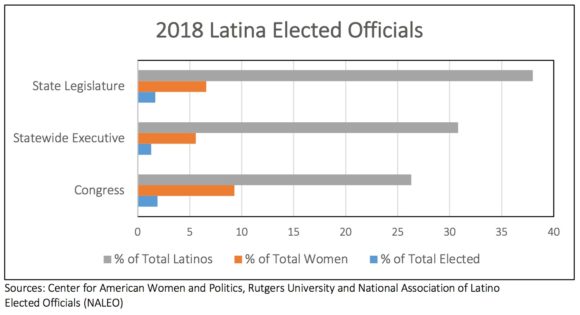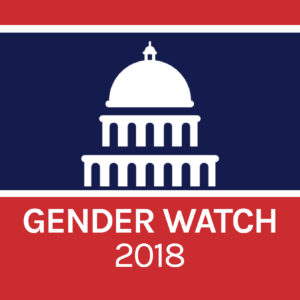Gender Watch 2018 experts recently offered alternative measures for success for women candidates this year. Rather than solely focus on who is winning their individual elections, we can also broaden our assessment of success for women in 2018. Women of color are proving vital to our changing political climate, both as key voters and political candidates. Their recent campaigns are also broadening our traditional political models for candidates and their campaigns.
In terms of measuring success for Latinas in 2018, we can look at the following recent signs of success for Latinas: historic primary re-imaginings, signs of the growing Latina influence on politics, and renewed efforts to support Latina leadership in the future. These glimmers of Latina political success emerge against the backdrop of a dire political climate for many groups, especially immigrants and women, and demonstrate the strength and resiliency of these communities as they organize, demonstrate, vote, and run for office. This hostile political climate is the definitive example of following through on a quote by the Latina human rights activist, Dolores Huerta, “Every moment is an organizing opportunity, every person a potential activist, every minute a chance to change the world.”
Significant Primary Wins for Latinas
There is a growing Latina influence on U.S. politics, which is highlighted by several historic primary wins so far in the 2018 election. These wins are significant not just because women advanced to general election contests, but also because they are breaking the mold for who is considered an ideal, traditional, viable candidate.
A recent example of success for a “new candidate” is Alexandria Ocasio-Cortez’s congressional primary win in New York. Ocasio-Cortez is a Latina first-time political candidate, who at 28 years old was able to defeat a 10-term congressman on June 26, 2018. She is a Bronx-born Democratic Socialist who credits her efficient grassroots campaign, which prioritized mobilizing the community over raising big campaign funds, for her success. Running in a strongly Democratic district, Ocasio-Cortez is likely to win in November, becoming just the second Latina elected to Congress from New York.
Two more Latinas are poised to join the freshman class of the 116th Congress in January 2019: Veronica Escobar (TX-16) and Sylvia Garcia (TX-29) are Democratic nominees in safely blue districts. Together, they will be the first Latinas ever elected to Congress from Texas.
Two other notable primary wins for Latinas come at the gubernatorial level, where Democratic nominees Michelle Lujan Grisham (D) in New Mexico and Lupe Valdez (D) in Texas are running to become the first Democratic Latina governor in the United States.
The significant wins for women of color this primary season also point to the established source of support from community outreach. Wendy Smooth highlighted this dynamic in her recent post on black women in Alabama politics. Smooth said, “Black women’s emergence as candidates is reflective of their long-term political investments and civic participation in Alabama and states like it where Black women have traditions of engaging formal politics as a vehicle for societal change.” Latinas also have “long-term political investments” and a history of civic participation, which I have previously argued is a key source of electoral support or a “Latina Advantage.” For example, Ocasio-Cortez credited her surprising primary win to her supporters. When talking about her political race in her campaign ad, she argues the fight is about people versus money, noting, “We’ve got people and they have money.”
With these examples of historic primary wins, Latinas are also navigating the unique challenges that can come from their distinction of being the possible ‘first’ in their campaigns. In a recent post, I previously highlighted some potential challenges and advantages that can come from the first’ distinction for many of the women of color running for office this year. In addition to being the ‘first’ Latina or woman of color to be elected from key states, there are additional challenges for first time candidates running for politics. Pearl Dowe discussed the challenges for first time candidates in her post on women running in Arkansas. Women candidates are likely to question their readiness, ability, qualifications, and established base of support to effectively run for office. Ocasio-Cortez highlights this challenge for first time candidates, especially those who are women of color, in her powerful campaign ad which starts with her saying, “women like me aren’t supposed to run for office.”
Growing Latina Influence on Politics
In addition, Latinas are also increasingly attracting political attention as voters, political candidates, and elected officials. In recent elections, including the 2016 presidential election, Latinas have increasingly attracted political attention since they join other women of color to reinforce the modern gender gap of increased voters supporting the Democratic presidential candidates.
However, in terms of elected officials, Latinas still face a stark underrepresentation. Latinas are about 17% of the U.S. population but only represent less than 2% of the total elected officials across Congress, statewide elected executive offices, and state legislatures.

There are currently 124 Latina state legislators, which represents 6.1% of all women and 38% of all Latinos. There are 10 Latinas in Congress, which is 9.3% of all women and 26.3% of all Latinos in Congress. Historically, Latinas have capped their presence in Congress at a high of 12 and 2016 ushered in the first Latina elected to the Senate with Sen. Cortez Masto. The 2018 election is a good opportunity to see a record high number of Latinas elected to Congress. Notably, of the 32 Latina House candidates still in the running, Escobar, Garcia, and Ocasio-Cortez are likely to join 7 Latina incumbents.

There are 4 Latinas in statewide executive office, which is steady from the 2016 numbers, and represents 5.5% of all women and 30.8% of all Latinos elected statewide. This includes one term-limited Latina governor, Susana Martinez in New Mexico, who is also the country’s only women of color governor. At this point in election 2018, at least 11 Latinas are still in the running for statewide elected executive offices, including the two Latina nominees for governor.
Overall, Latinas have made steady strides in political office and represent a substantial proportion of all Latinos elected to office, but there remains progress left to make on the path to representation that reflects Latinas share of the population.
Renewed Efforts to Support Latina Leadership Pipeline
Another potential success marker for this year’s 2018 election is the amplified call of attention to gender issues impacting women’s pipelines to leadership. I recently participated in a Latina-focused panel at the NALEO national conference in Arizona, which acts as one of many examples of how organizations can work towards connecting the dots to both recognize and tackle the existing obstacles for women in leadership roles. NALEO, or the National Association of Latino Elected Officials, hosted their annual conference to provide elected/appointed Latino political officials with opportunities for professional development, public policy discussion, and discussion of the key concerns affecting Latino communities. These goals are especially beneficial given the challenges of navigating today’s increasingly hostile political environment.
I was honored to join NALEO’s all-female panel “Beyond #MeToo: Blueprint for Developing Pipelines for Latina Leadership and Power.” The unique Latina-focused panel discussed ways to harness the political momentum revolving around the #MeToo movement to more effectively champion solutions for creating safer work environments and developing leadership pipelines for Latina leaders. This discussion included calls to speak up and confront bad behavior; to acknowledge the intersectional dynamic to discrimination and harassment; and to increase transparency, accountability, and prevention.
The Latina panel is one demonstration of renewed calls to confront the political obstacles encountered by women of color and offer lasting support strategies. Some future strategies that can improve the pipeline for Latinas in political leadership include political parties and organizations acknowledging that women of color are viable candidates and pivotal voters. This diverse community cannot be taken for granted. The Latinas running in 2018 are valuable role models who are displaying multiple ways to think about viable and strong candidates. To continue to build a larger and stronger Latina political pipeline it is important to support more leadership and candidate training opportunities for women of color.


 From March to December 2018, the
From March to December 2018, the